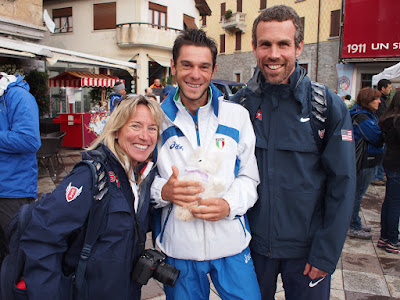The following article originally appeared in the December 2013 issue of ATRA Trail Times email newsletter:
by Herb Kieklak
The Endurance Runs in Flagstaff, AZ, are spectacular – true treasures in the world of trail running. Held in mid-September, the events — 50 kilometer and 50 miles — combine high altitude, gorgeous scenery, and very challenging terrain.
The runs are organized by Aravaipa Running which is operated by the brother team of Nick and Jamil Coury, both successful runners on the ultra circuit. The pair is easy to talk with about training ideas and honest about directing you to the race that is best suited for you. I enjoy locally-grown events of this type, rather than corporate, large-scale events, because even a non-local runner like me can feel at home and enjoy running with friends old and new. I have run several of their events and can attest to amazing volunteer support, incredible swag, super helpful race directors and challenging courses.
The Flagstaff Endurance Runs took several years to get approved due to many environmental factors, but the organizers persisted, and eventually were able to map out a course which was agreeable to those issuing permits.
Before registering for the event, it is a good idea to pay heed to their warning: The combination of elevation gain/loss and Flagstaff’s high altitude makes the courses very difficult and NOT recommended for beginning trail runners.
From personal experience, I can attest to the validity of their claims. Last year, I attempted the course and experienced my first-ever DNF, as the high altitude nailed me late in the race – of course training in Florida is not very beneficial when it comes to high altitude racing. This year, I was determined to make amends for that blemish on my ultrarunning record.
I adjusted my training program and added a day of acclimation per advice of race director Nick Coury. Last year, I had arrived the afternoon before the race on suggestion of many runners to “get in and get out” before the altitude change hits you. It may have worked if I was running an East Coast trail race. However, this race is so totally different than any East Coast race, that there is no quick “get in and get out.”
The Flagstaff Run starts at 7,000 feet of elevation which makes it high altitude from the first step, unless of course you live at that elevation. The course has several bodacious climbs, (again speaking as an East Coast runner), and what I call “white knuckle descents.” Obviously, living in the great Southwest would be a huge advantage for running these highly technical, ankle-twisting trails. Somehow, I can’t imagine running fast down the side of a mountain, while on narrow, rocky single-track trail when a single misstep means a nasty fall. And to make it worse, there is the AWESOME view while coming downhill which beckons runners to stop and take in the vista.
You break out of the ridge above the trees to a wide open mountainside and have spectacular views of Flagstaff, granite walls , huge Ponderosa pines and quaking Aspens in the midst of fall color change. You are torn between taking in the impressive scenery, or watching the trail to make sure you don’t bust your #*&. This year we had the extra” treat” of a rare desert rain storm and Holy Moley...what a storm. It thundered and shook like the Second Coming. So now I am running, albeit plodding on the uphills, and having thoughts of flash floods, and the addition of mud and water to already treacherous downhill trails. Luckily,the rain came in spurts and at 9,000 feet turned to hail instead of rain.
At the third peak of 9,000 feet, some 20 miles into the race, my legs felt like lead and I started getting dry heaves and was “a little worried” that I would DNF again. But luckily, the route soon dropped to 8,000 feet and I soon started to feel better and news that the next aid station was only 5 miles away instead of 9 ,like the last couple, was a big mental boost.
Along the way, I was joined by another runner that I had been playing leapfrog with throughout the race. This was great as we all know how much more fun it is to have a pace/run buddy. At the next station, there was the added benefit of meeting some ex-Floridians, who turned out to own Sedona Running Company. They could commiserate about training in mountainless Florida as a preparation to run in altitude-laden Arizona. After that break, I was refreshed mentally and physically (Gatorade and M&Ms) and ready to “blast” the last three miles to the finish.
I was amazed I was able to put in a strong finish when I got “down” to 7,000 feet and how much different if felt than up at the top. This year, I was proud to collect my finisher mug and very grateful to Nick Coury for his advice on preparation.















